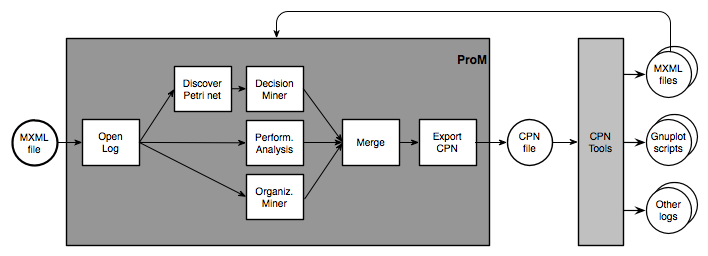Simulation-relevant information can be obtained from an event log via a combination of various process mining techniques, and subsequently can be automatically included in a CPN model. We believe that the combination of automatic discovery of process models using ProM and the simulation capabilities of CPN Tools offers an innovative way to improve business processes. The initially discovered process model describes reality better than most hand-crafted simulation models. Moreover, the simulation models are constructed in such a way that it is easy to explore various redesigns.
You can follow the steps in this tutorial to create a simulation model including data, timing behavior, and resources as described in the running example of [1].
The following overview picture shows the dependencies between the main steps that need to be take to generate a simulation model from an event log only. Several plug-ins are used to obtain simulation-relevant information about data, timing, and resources in the process. Then, these different types of information can be merged and exported as a CPN.

You can now follow the steps using one of the example files (see below). Note that instead of using the menu as described, it is usually quicker use the action trigger by pressing the “Play” button in the toolbar.
- Open the log via choosing File → Open MXML Log file from the menu (or pressing the left-most toolbar button).
- Invoke the Analysis → Basic Log Statistics plug-in to calculate timing information and typical attribute values.
- Go back to the log window and change to the “Filter” tab, where you should toggle the event type “start” once so that it displays “remove” (instead of “keep”). Then invoke the Mining → Filtered [log] → Alpha algorithm plugin and start the mining with default settings.
- Now you can invoke the Decision Miner choosing Analysis → Selected Petri net → Decision Point Analysis from the menu. Press the button “Update results” to discover the decision rules.
- Go back to the log window and invoke the Mining → Filtered [log] → Organizational Miner plug-in. Choose “Doing Similar Task” and start the mining.
- To combine the three results, use the Merge Simulation Models plug-in as described. Use the Data Simulation Model provided by the Decision Miner as the reference model, and merge it with the simulation models provided by the Organizational Miner and the Basic Log Statistics plug-in.
- The merged simulation model can now be exported to CPN Tools by choosing Analysis → CPN Tools 2.0 from the menu.
These are the files that can be used to reproduce the steps described:
- Event log for the outpatient clinic example (used in the publication below)
- Event log for the insurance company example (used in earlier publications)
-
Discovering Simulation Models
A. Rozinat, R.S. Mans, M. Song, and W.M.P. van der Aalst
BETA Working Paper Series, WP 223, Eindhoven University of Technology, Eindhoven, 2007 -
Discovering Simulation Models
A. Rozinat, R.S. Mans, M. Song, and W.M.P. van der Aalst
Information Systems, Vol. 34, pages 305-327, 2009